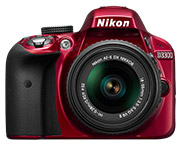Tom's Guide Verdict
The Nikon D3300 is an excellent entry-level camera for aspiring photographers, delivering a good feature set and high-quality images.
Pros
- +
Small for a DSLR
- +
Retracting lens makes camera compact
- +
Sharp, clear images with accurate color
- +
Video has smooth movement
- +
Great price
Cons
- -
No tilting LCD screen
- -
Limited shooting controls, such as noise reduction options
- -
More noise (graininess) than many rivals capture in low-light stills and video
Why you can trust Tom's Guide
If you are considering an upgrade from a point-and-shoot, the Nikon D3300 is one heck of a DSLR for newbies. It succeeds the very popular D3200 with a few upgrades, such as better video capabilities. The D3300 lacks the bells and whistles of its more expensive cousins, such as Nikon’s own D5300 ($800), but it takes sharp, clean 24.3-megapixel images and smooth, natural-looking video. Priced at less than $400 for the kit with an 18-55mm lens, the D3300 competes directly with value-priced DSLRs like the Canon T5 and with midrange mirrorless cameras like the $499 Olympus PEN E-PL5. And it stacks up very nicely.
Design
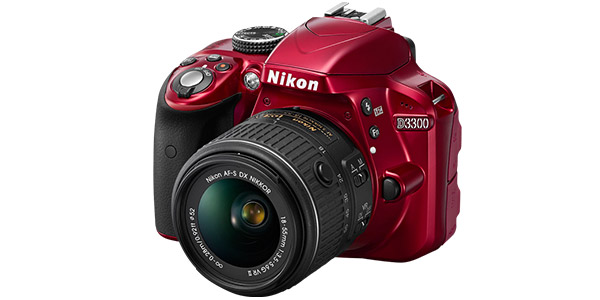
The D3300 has the standard Nikon DSLR design, with a utilitarian plastic body. We tested a version in matte black, but Nikon also offers the D3300 in red and slate gray. The D3300 is a little lighter than other Nikon DSLRs. It weighs 14.5 ounces for the body only, compared to 16.9 ounces for Nikon's D5300, but it also feels less sturdy. However, the D3300 is heavier than most micro four-thirds mirrorless cameras, such as the Olympus PEN E-PL5, which weighs just 11 ounces.
MORE: Best DSLRs
On the back of the body is a 3-inch 921k pixel LCD. Images on the screen are clear and fairly bright, but viewability suffers in direct sunlight. This display can't flip out or rotate, so there is no selfie shooting or ability to hold the camera above or below to get a challenging shot. The D3300 shares this lack of a rotating screen with the Canon Digital Rebel T5, but the Olympus PEN E-PL5 and some other competing mirrorless cameras have tilting LCDs. As a DSLR, the D3300 has an optical viewfinder, in this case a bright model that includes a minimal LCD at the bottom of the frame to display basic settings info.
In addition to a small built-in pop-up flash, the D3300 offers a standard hot shoe, which means it can work with flash units from Nikon and other manufacturers.
Controls

Buttons are strewn around the D3300's LCD like teenagers at a pool party, but with a better sense of order. The four on the left side of the screen are for viewing and zooming into captured images and accessing the on-screen menu. The five buttons on the right, along with the adjacent four-way directional pad, control the shooting settings and live view mode (more on that later).
Atop the right handgrip, three buttons (movie capture, info and exposure compensation) are grouped around the shutter button, which makes it easy to quickly tweak exposure or switch between capturing stills and video. This design is an instructive example for other camera makers that bury the video-record button in hard-to-reach spots.
Get instant access to breaking news, the hottest reviews, great deals and helpful tips.
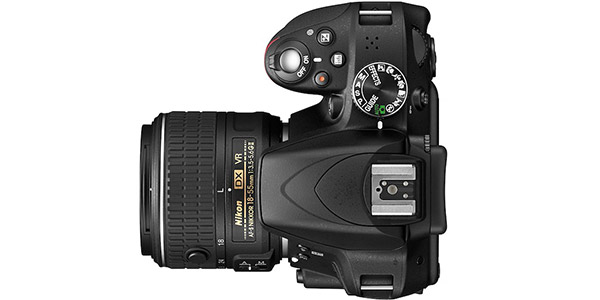
Most of the frequently used controls fall comfortably under the fingertips for one-handed shooting: your thumb can easily reach the control dial on the camera back while shooting with your eye next to the viewfinder. This makes it easy to control the aperture in aperture priority mode, but it doesn't give you the control over both shutter and aperture that dual dials offer (as on the Nikon D5300).
Next to the dial is the AE lock button, so you can lock in an exposure setting in a complex lighting situation without having to take your eye off the subject. Unlike its more expensive cousin, the D5300, the D3300 does not offer any customizable buttons or dials, and there is no way to reprogram the functions of the buttons on the camera body.
Like all DSLRs, the D3300 uses a mirror to bounce the light from the lens up into the optical viewfinder while you are framing a shot, and then flips the mirror out of the way while taking the image. A live view mode is also available. When you press the LV button on the right side of the camera back, the mirror flips up, and a preview image appears on the LCD. This preview looks great in good light, but gets rather dull and grainy in low light. That's a common problem with live view modes on all DSLRs and mirrorless cameras, however.
The D3300 scores acceptably in our test of how easy it is to access key settings.
| Setting | Steps/button presses | Function |
|---|---|---|
| Shutter | 1 | Length of exposure |
| Aperture | 1 | Amount of light let in |
| ISO | 1 | Light sensitivity |
| Focus Mode | 2 | Points or points used for focus |
| Light metering | 2 | Part of image with optimized exposure |
| White balance | 3 | Overall color cast of image |
| Exposure compensation | 1 | Set auto exposure to be darker or lighter |
| Wi-Fi sharing | N/A | Send images to smartphone, activate remote viewfinder |
| Video recording | 1 | Switch from photo to video and back |
| Play | 1 | View images or videos and back |
| Delete image | 1 | Self-explanatory |
| Photo capture resolution | 2 | Amount of megapixels |
| Photo capture quality | 1 | Amount of JPEG compression/detail, or RAW |
| Video capture resolution | 4 | Lines of resolution and frame rate |
| Video capture quality | 5 | Amount of compression / detail |
| Drive | 1 | Single photo, burst, timer, etc. |
Image Quality
Overall, the D3300 snapped high-quality images using its 24.3-megapixel sensor, with strong detail and accurate color in bright light but noticeable noise (graininess) by low light at high ISO (sensitivity) settings. Although the resolution of the D3300 is unchanged from its predecessor (the D3200), Nikon has tweaked the sensor by removing the optical low-pass filter (OLPF), which softens the image slightly to make sharp edges look more natural. We didn't see a lot of difference between the two models, though: both models produced very sharp images with a fine level of detail.
To get comparable results, we test all mainstream DSLRs and mirrorless cameras —those with a so-called APS-C-size sensor — using a prime (non-zooming) lens of roughly a 32 mm focal length, which is equivalent to a 50mm on a full frame camera. In this case, we chose Nikon's 35mm f/1.8G, which sells for $196. We also spot-checked against Nikon's 18-55mm Zoom Lens, which you can purchase with the D3300. The 35mm-prime is slightly sharper than the kit lens, meaning you won't see all the camera is capable of with the packaged lens.
MORE: DSLR vs. Mirrorless Cameras: Which Is Better for You?
Daylight results
The D3300 did an admirable job shooting in bright light, capturing both the highlights and shadow details of a scene. We found that the images were accurately exposed in most of our test shots in daylight when using the program mode of the camera.
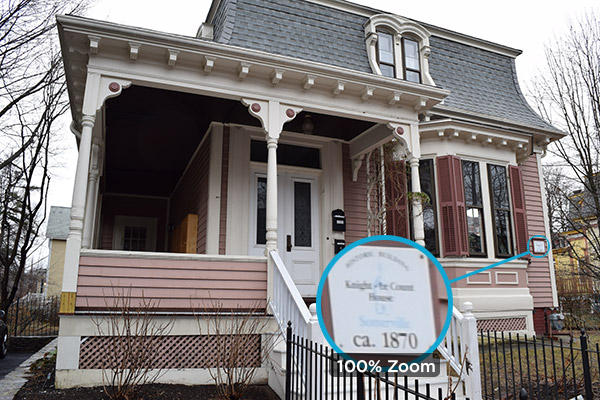
The D3300 captures very detailed images. In a photo of a historic home shot with the kit lens, we could zoom in to see the date on the plaque and almost read the gas meter at the corner of the house. The kit lens does introduce some distortion, though. The window frames appeared slightly curved, due to a lens effect called barrel distortion that is common with entry-level zooms. The D3300 does try to remove this effect by processing the captured image when it is saved, but it didn’t quite get it in this shot.

Colors appeared very rich. In a photo of a crochet piece, for example, the hues of the different yarn appear very similar to how they did in real life: subtle colors that were muted by repeated exposure to the sun.
Low-light results
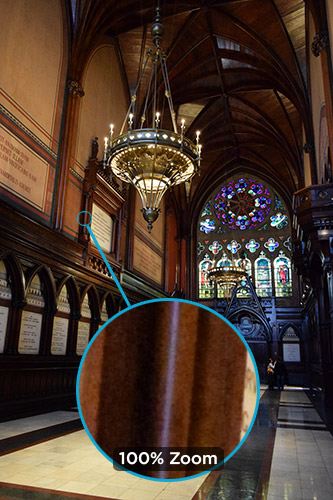
The D3300 performed well in dim settings, capturing a fair amount of light. We first took a hand-held, low-light shot of the memorial transept at Harvard in auto mode. In this shot, the camera upped the ISO (light sensitivity) to 6400 to keep the shutter speed fast to avoid blur. The image exhibited a fair level of detail, but closeexamination showed some noise (graininess) in the wood paneling and shadows. But that's to be expected at such a relatively high ISO.
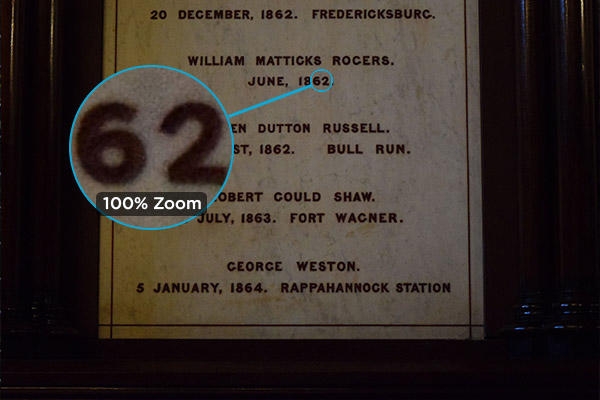
A shot of a memorial plaque in the same transept in low light shows the same issue. The edges of the names are not sharp, because the noise has softened the details somewhat.
The noise level of the image increases as the ISO level goes up. Noise reduction removes much of the noise, but also a lot of the fine detail.
We didn't see much noise in our analysis of the captured JPEG images at lower ISOs, but some started creeping into images at ISO settings above 1600. This noise became more pronounced when we took photos in low light, which needed higher ISO settings of 3200 and above, although the camera's built-in noise-reduction (NR) feature did ameliorate the graininess somewhat.
This did have a cost, however. The noise reduction also removed some fine details in the images. It is possible to strike a better balance between noise reduction and detail using RAW images and a program such as Photoshop that allows you to apply more finesse to the noise-reduction process.
MORE: How Many Megapixels Do You Really Need?
Although the camera technically supports an astronomical ISO of 25600, we'd advise not shooting above ISO 3200 for a large image if you can avoid it. If you are printing smaller images or posting them to Facebook, the noise and noise-reduction effects are tolerable up to ISO 6400.
Most cameras allow you to set different levels of noise reduction, to find an adequate balance between the amount of noise and the loss of detail that noise- reduction entails. The D3300 offers a binary On/Off option for noise reduction, though, without in-between levels. Also missing is long-exposure noise reduction, in which the camera tries to remove noise in longer exposures by capturing a dark frame (one with the shutter closed, so all it contains is the noise) and subtracting it from the image.
Video quality
The video that the D3300 captured was of similarly high quality as the still images, with strong, bright color in good light and plenty of detail. Video is captured at a maximum resolution of 1920 by 1080 pixels at 60 frames per second in H.264 or MP4 format. That's rather unusual: most entry-level cameras capture 1080p video at only 30 frames per second. Impressive for this class of camera, we saw little evidence of the common rolling shutter effect, where fast camera pans and movement in the frame causes a wobbly looking effect.
Video clips are limited to just 10 minutes in length, which could be a problem if you want to film your child's play or dance recital, for example. Most digital cameras limit the maximum length of video clips, but usually to 20 or 30 minutes.
Shot in daylight at the highest-quality settings that the D3300 offers, a video of moving cars showed smooth motion and a good amount of detail in each frame. The audio, however, is weak. The stereo microphones were easily overwhelmed by the noise, thereby distorting the sound. There was also little or no stereo separation: you don't get the feeling of a car passing close by on the left side, for example.
The D3300 includes a stereo mic jack for an external microphone, which we recommend using for high-quality audio. Nikon sells an external stereo microphone for $179 that plugs into the camera's hot shoe on top of the camera.
Not surprisingly, nighttime video was grainier. A video shot at the highest-quality settings under a streetlight showed a lot of noise, and the camera failed to adapt for the streetlight illumination, giving the video a heavy amber cast. The movement, however, still remains mostly smooth.
Autofocus and speed
The D3300 is a quick camera to focus: shooting through the viewfinder, we found that the small 18-55mm zoom lens snapped into focus quickly using any of the 11 focus points. In a candid shot of a cuddling kitten, we got the photo quickly without disturbing the (semi-)wildlife: When we were shooting through the viewfinder, the camera focused and took the shot before the subject could wake up and attack.
Focusing speed is largely about the lens. Autofocus with the 35mm prime lens that we also used was significantly quicker. However, the kit lens was fast enough to capture most subjects in our tests.
In live view mode, the D3300's focus was a lot less impressive. The point-and-shoot-style contrast detection focusing system used in live view created a slow, to-and-fro searching motion of the lens, especially in low light. Some more-expensive DSLRs and mirrorless cameras are incorporating faster phase-detection focus sensors into the imaging chip, but the D3300 isn't one of them.
The D3300 is a speedy shooter. We found that it was capable of capturing the 5 frames a second that Nikon claims when shooting in the Fine JPEG mode with a fast 32GB SanDisk Ultra UHC-1 SDXC card. With this card, we were able to shoot an impressive 17 photos before the camera had to slow down for the images to be stored.
Kit lens
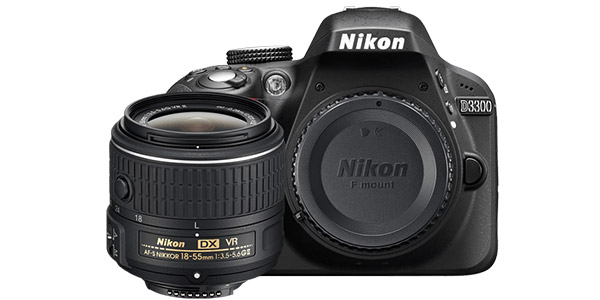
The kit lens that Nikon bundles with the D3300 is an 18-55mm, f3.5-5.6 zoom with built in VR (vibration reduction), Nikon’s own moniker for image stabilization. This slightly unusual lens has a lock button on the zoom ring; when you press the button, the barrel of the lens retracts from 3.5 inches long down to 2.5 inches for easier handling and storage. When you want to start shooting, you push the button and twist the zoom ring to expand the lens.
While that keeps the lens as small as possible, it is a problem for candid photography: unlocking the lens takes time and looks fairly obvious if you are trying to shoot unobtrusively. This mechanism also means that you start off at the wide-angle (18mm) setting every time you unlock the lens. The hassle factor here is fairly minor, though.
Image quality was generally good, though details come out softer than they would when using a sharper lens, such as the 35mm f/1.8G we also used in testing. In addition, the lens produced some geometric distortion at the wide end, but that's to be expected on a low-cost lens. Fortunately, the camera's processing software helps to ameliorate the distortion.
Lenses and accessories
The F mount that the D3300 uses provides access to a huge selection of lenses, from ultra-wide angles to very long telephotos. There are hundreds of compatible lenses on offer, from both Nikon and other manufacturers, such as Sigma, that range from a few hundred to a few thousand dollars. Some older lenses aren't fully supported, though. Lenses in the AF-S and AF-I families work with all features of the D3300. Others may offer only manual focus or not allow the light-metering features of the camera to be used.
MORE: Best Mirrorless Cameras
The lens selection is one of the factors that make the D3300 such a good starter DSLR. Many lenses you buy for this camera will work with higher-end Nikons you may upgrade to in the future.
The D3300 offers a standard hot shoe, so it is compatible with a range of flash devices from Nikon and other manufacturers. A microphone jack on the left side of the camera body allows you to connect an external microphone. But no "phantom power" is offered, which means some professional microphones that require additional power input won't work. This is not unusual for a DSLR, and in fact the inclusion of a mic jack is a bonus for a camera in this price range.
Bottom Line
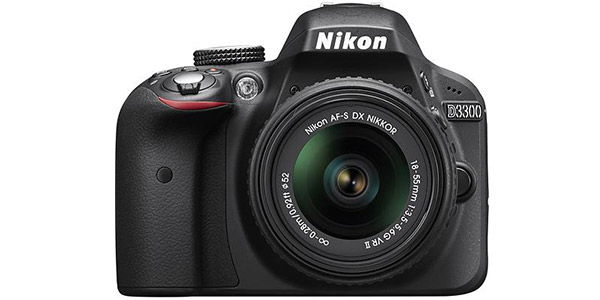
The fact that you can buy a 24.3-megapixel DSLR (with a decent lens) for $650 shows how competitive the digital camera market has gotten recently. The Nikon D3300 is an excellent entry-level DSLR camera for aspiring photographers, delivering a good feature set and high-quality images.
Specs table
Nikon D3300
24.2 effective Megapixels
DSLR
$649 (with 18-50mm lens)
5 fps burst mode
Nikon DX (APS-C) CMOS Sensor
18-50mm f3.5-5.6 kit lens
11 Contrast detection AF Points
Shutter speed 30 to 1/4000 second
ISO 100- 25600
Video resolution 1080p, 720p, VGA at 60 and 30fps
Built-in flash
Standard hot shoe
SDXC Card slot
Mic, HDMI, miniUSB
Optical lens image stabilization (VR) in kit lens
4.9 by 3.9 by 3 inches
1 lb. 2.7 oz.
Richard Baguley has been working as a technology writer and journalist since 1993. As well as contributing to Tom's Guide, he writes for Cnet, T3, Wired and many other publications.
